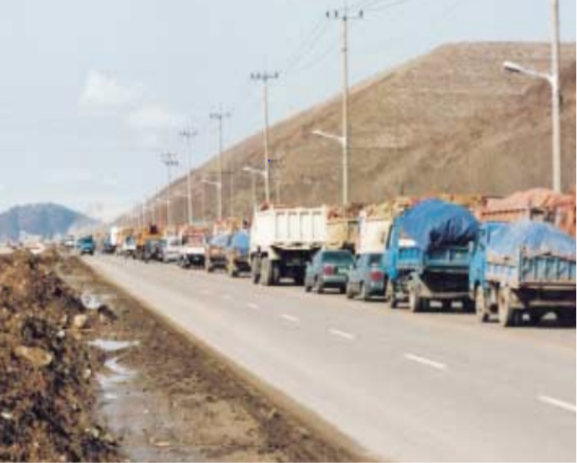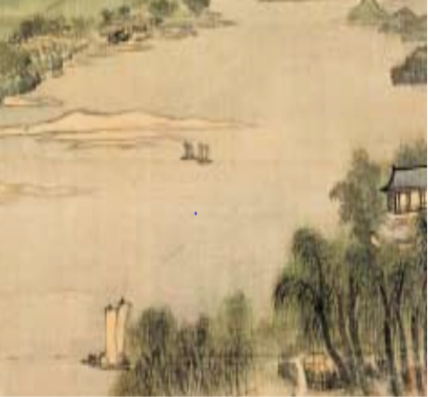Landfill Recovery Project : Transformation of Landfill to Ecological Park
Introduction
Nanjido is a name of an island on a branch of Han River that was the city’s official dump site. Rapid urbanization and growth led the once beautiful island to resemble a huge mountain of garbage. Seoul, however, succeeded in transforming this landfill site to an eco-friendly park, a space for nature and human to exist harmoniously together.
Beautiful Nanjido, Before Becoming Land of Death
The Korean word Nanjido means an island of abundant orchids and gromwells. This low-lying island located on Han river was once a beautiful island known for its array of seasonal flowers, cabbage, radish, cantaloupes and peanuts which were widely cultivated. It was also a habitat for a wide range of birds that flock to the area for aquatic animals found abundant in the clean water
Nanjido under Development Projects
On January 7, 1999, the Seoul Metropolitan Government commenced the Nanji Bank Revetment Works Project remapping the areas surrounding the river. A bridge and paved road connecting Nanjido and Han River was additionally constructed after the project was completed. Conveniently l0cated close to highway, the island was later chosen as the site to host an 18.6km Grand Canal connecting Incheon and Nanjido in 1970. Eyes were fixed on Nanjido and its future development as a multipurpose dam along with many other construction works were slated for this place.
Mountain of Garbage
Rapid urbanization and economic growth in Seoul inevitably increased waste volume from household and industrial sites. However, due to lack of official waste disposal sites, municipal solid waste has generally been disposed of at open landfill sites, such as residential area and low marsh. The city government scrambled to find a large-scale landfill that would accommodate the ever increasing trash. Nanjido was chosen as Seoul’s official dump site in 1978 for its easy accessibility and distance from the downtown Seoul. Since this point, the once beautiful island with promising outlook slowly turned to land of death. From March 1978, trash began to be filled here, and in 1988 28,877 tons of garbage was gushed out to the landfill site every day. It wasn’t until November 26, 1992 when a metropolitan landfill was established to accommodate all trash generated from Seoul, Incheon and Gyeonggi Province that the gushing finally stopped.
Transformation into Ecological Park
Piled up with garbage without any hygiene measure, Nanjido became a dangerous eyesore that oozed malodor, harmful gases such as methane as well as effluents. Nanjido destroyed air and water quality of Han river and he surrounding ecosystem. Seoul began channeling all-out efforts to transform the trash heap into a large green space, replete with parks, sculpture, trails, and dazzling views of Seoul.
Nanjido Recovery Project: Land Stabilization Process
The Seoul government began to rethink their plans for Nanjido, and after thorough planning from 1991 to 1996, a major Landfill Recovery Project took off. Seoul focuses on the land stabilization first, and the goals of this major initiative have been to restore the ecosystems of the once-beautiful island of Nanjido. This project focused on four areas of development: Top soil leveling and Soil-Recovery, Leachate Treatment, Extraction and Recycling of Landfill Gas, and Slope Stabilization.
Turning the Landfill into Park
Along with the land stabilization process, Seoul also began shaping this land into a park. Nanjido’s location makes it a perfect place as a gateway to the global stage and to North Korea when the two Koreas are united.
In fact, Sangam-dong where the landfill is located was chosen as the construction site for the 2002 World Cup stadium. The decision brought about the need for the area’s transformation into an eco-park. Goals of the project were clear; Seoul was to show the world that a land of death, symbolic of ill effects of urbanization and industrialization could be reborn as an ecological space.
To give form to the grand plan, Seoul began taking in valuable inputs from all stakeholders; it held an international symposium in December 1999, launched a committee for the world cup park plan in March 2000, and held workshops 4 times from March to April 2000. The voices all called out for a sustainable development and coexistence between nature and human beings. Based on the plan, design for the World Cup Par began in 2000 and the construction was finally completed in May 2002. The grand World Cup Park had 5 smaller parks within the site, namely Nanjicheon Park, Noeul Park, Haneul Park, Pyonghwa Park, and Nanji Han River Park.
Internationally Recognized Landfill Recovery Project
Turning Landfill Gas to Energy
Methane was one of the major gases generated from the Nanjido landfill. The city of Seoul installed 106 methane gas extraction wells at the interval of 120m throughout the former Nanjido landfill site. The gases are then channeled into wells using fan, which are then used to provide heating for 3 public sites including World Cup Stadium, 40 office buildings, and 16,335 households in the surrounding residential areas.
From 2002 to 2014, energy generated from the gases provided to 43,851,787m3 which is equivalent to KRW 8,770,712,570 in total (73,089,000 KRW annually) in monetary terms. Of course this is an astonishing financial benefit. What is more significant, however, is the environmental benefits of the project.
Ecosystem in Recovery
After opening the 2002 World Cup Park to the public, Seoul conducted a systematic analysis on the ecological changes of the area. To get data, Seoul conducted a yearly monitoring on the progress in terms of ecological recovery and park status. Several years of monitoring found that the number of species (both plant
and animal) jumped from a mere 438 kinds in 2000 to 1,092 in 2013. The figures suggest that the pollutants have diminished in the park and that Nanjido is no longer a land of death. The clean air and refreshing waters of the Hangang River, the flowers and trees living in harmony with the animals, represent nothing short of a spectacular environmental renewal.
World Cup Park, a New Landmark of Seoul
Today, the World Cup Park attracts 10 million visitors annually. The Park offers a wide range of special programs, performances and festivals such as the famous silver grass festival at Haneul Park located within the World Cup Park. It also serves as a popular destination for camping and fun golfing outings.
Seoul’s Efforts Recognized Worldwide
The Nanjido rebirth project is highly regarded in the international community. Around 3,000 officials from the world wishing to benchmark Seoul’s exemplary case visit the World Cup Park every year to learn about Seoul’s experience and insight. In fact, Seoul garnered the Special Award from United Nations Human Settlements Program (UN-HABITAT) for its landfill recovery project. The award is one of the most prestigious awards given to acknowledge initiatives which have made outstanding contributions towards developing and improving human settlement and the quality of urban life.
Timeline
Figure 1. Vehicles heading for Nanjido on the Jayuro
(source : http://worldcuppark.seoul.go.kr)
But the insanitary burying caused leachate during the entire burying period which led to serious land and water pollution. The landfill gas was also prone to catching fire at times. The environmental arrangement of the landfill was politically highlighted in 1990. The basic master plan of the ‘Seoul, Capitalization 600 Yyears-old capital city project’ was established in 1992 for the strategic development of Yeouido, Yongsan, Sangam, Tukseom, and the Magok area. A special urban development plan was prepared for Sangam, where Nanjido was located, reflecting that it was a gateway of both globalization and the unification of the South and North as the key area of Northwestern Seoul. In addition, there was a need to fix the local environment in order to build a world-cup stadium following the decision to build the 2002 Korea-Japan World-Cup stadium in Sangam in May, 1998. Moreover, the ‘New Seoul, Our Han River’ project that included the basic millennium park plan of Seoul in 1999 also included the Nanjido landfill stabilization and park construction plans.
The Nanjido landfill stabilization and park construction plans were quickly implemented for the World Cup. The landfill stabilization project was initiated in January, 1998 and finished in October, 2002 after 4 years and 10 months. The construction company was selected and started work within 3 months of finishing the design so as to shorten the construction period. An ecological park was also constructed from October, 2000 to June, 2002 alongside the stabilization project (KSP, 2014). The waste buried under Nanjido is still being biodegraded, and Seoul estimates that the stabilization will continue until 2020.
Situation: Background
Figure 2. Geumseongpyeongsa in Geyonggyomyeongseungcheop: Gyeomjae Jeongseon 1676-1759
(Source: http://worldcuppark.seoul.go.kr)
Nanjido landfill was operated in typically insanitary ways – without any solution for gas generation, leachate, flying waste, or the harmful insects. The excessive volume of waste caused many problems. More importantly, the insanitary operation caused land, water, and air pollution with the leachate and landfill gas while the unplanned and excessive landfill caused safety issues including ground subsidence and slope collapse. The leachate had very high Biological Oxygen Demand (BOD) of 72mg/l, Chemical Oxygen Demand (COD) of 605mg/l, and Total Nitrogen (T-N) of 1,416mg/l, which can have adverse effects on neighboring streams, The Han River is connected to the streams, and this underground water is directly connected to the health of citizens. The landfill gas generated by the waste degradation process is mainly composed of greenhouse gases such as methane and carbon dioxide; the former is very flammable and explosive so Nanjido experienced several fire accidents. At the same time, unbalanced subsidence during the degradation and the massive weight of the waste layers gradually removed space so the leachate level and possibility of slope collapse increased. In addition, the waste trucks caused serious pollution including dust and noise.
Figure 3. Nanjido Landfill
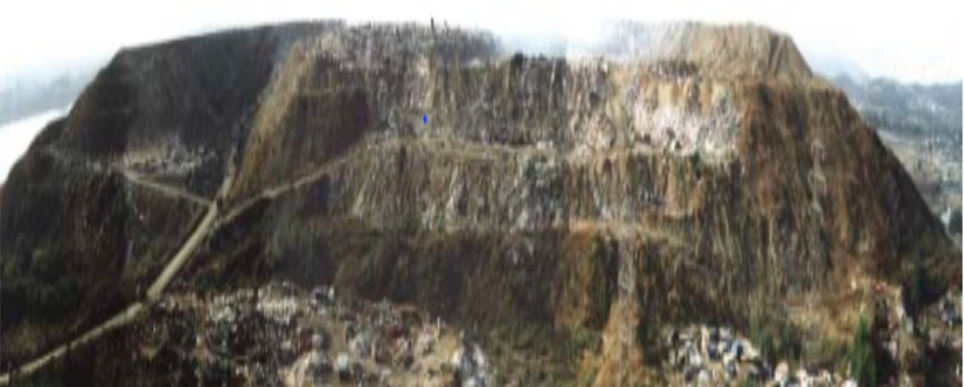
(Source: World-cup Park Management Office (2006) Nanjido recovers the scent)
Besides the environmental issues, the Nanjido landfill caused social issues. The Nanjido landfill was a living foundation for the urban poor who made their living with goods found from the waste. They suffered from the odors, dust, insects, birds, and air pollutants from the trucks every day. They also lived in very poor brick housing around the waste piles provided by the Seoul City Government. In a word, they were exposed to risks of environment, health, and safety.
Figure 4. Nanjido people collecting waste
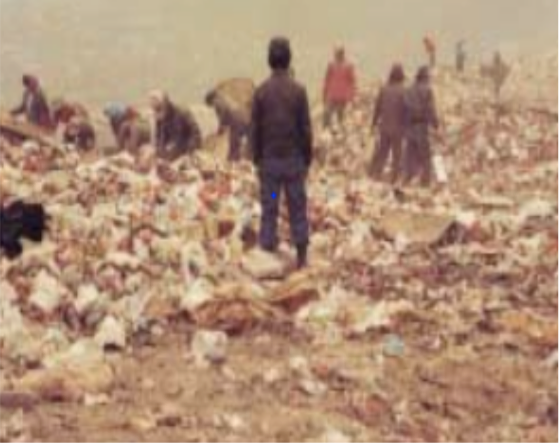
(Source: http://worldcuppark.seoul.go.kr)
From the end of 1992, Seoul began to dump its waste at the Sudokown Landfill and finally stopped using Nanjido from 1994. Nanjido had been used as Seoul landfill for 15 years from 1978 to 1993. But the environmental issues of landfill did not suddenly disappear. As the landfill ceased, social issues appeared – including jobs and housing for the urban poor. Furthermore, Seoul had to discuss how to use the once-landfill land. Academia and various industries had different ideas regarding the early development and long-term development following the stabilization of Nanjido. The ‘Early Development’ was to relocate the buried waste to coastal landfill sites or other locations and then redevelop it as a housing or business site. On the other hand, the ‘Long-term Development following Stabilization’ was to develop it in the long term when the conditions were established after installing pollution prevention facilities for landfill gas and leachate, stabilizing the land, and finally building an environmental and ecological park on the ground. After analyzing the different aspects, Seoul decided “to maintain the current situation and postpone the development while preventing environmental pollution and stabilizing it.”
The Importance of the Policy
Firstly, the Nanjido Stabilization project was a case in which Seoul took the lead in managing the waste landfill instead of the central government. In 1993, when the Nanjido landfill had ceased being used, there were no follow-up management regulations in Korea.
Post-landfill management regulations were found in the Waste Management Act in 1996 for the first time in Korea focusing on “establishing engineering solutions for appropriate follow-up management of landfills to be closed after 1998 and obliging environmental management for over 20 years.” In 2010, the follow-up management regulations were reinforced to extend the follow-up environment management period to 30 years. Nanjido stopped being used for the burial of waste in 1993 so it was not subject to those regulations.
However, Seoul predicted political changes of sustainable waste management in Korea and overseas countries and preemptively opted for landfill stabilization and thus creating a good example of post-landfill management.
Secondly, the Nanjido Ecological Park is connected to surrounding green areas and an ecology stream for self-sustainable recovery of the ecological functions. The Nanjido Ecological Park meets the Han River, Bulkwang Stream, Hongje Stream, and Hyangdong Stream while the grass fields on their watersides is connected to that of Nanjido Ecological Park. Even though Seoul is not home to much in the way of artificial features or design, except for some food plants and improvement of the habitat around the Nanjido park, the number of animals and plants have increased around the surrounding ecological space after developing the park.
Figure 5. Green field and streams around Nanjido Ecological Park
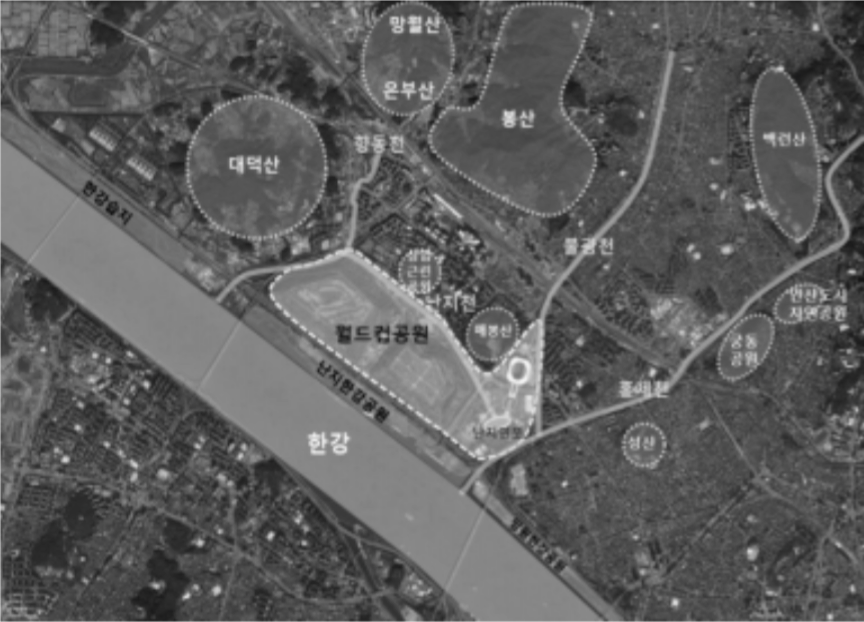
(Source: Seoul Institute, 2014, “2014 Economic Development Experience Modularization Project: Recovery of Nanjido Ecological Park”)
Thirdly, the landfill gas obtained as part of the stabilization is used for district heating contributions to the ‘resource cycling’ city development policy of Seoul. Methane is one of the most valuable fuels, and about 232,572K ㎥ of landfill gas had been used at the Nanjido Ecological Park from 2002 to December, 2013, which amounts to about 8.2 billion KRW of economic value. The collected landfill gas is supplied to a district heating facility located in the Nanjido Ecological Park. The park has an incineration facility (capacity of 750 tons) for handling the domestic waste of neighbors while the heat is collected and then supplied to the district heating facility. It is a unique and rare occurrence to have landfill gas collection, domestic waste incineration, and district heating facilities all in one ecological park.
Figure 6. Mapo Resource Recollection Facility
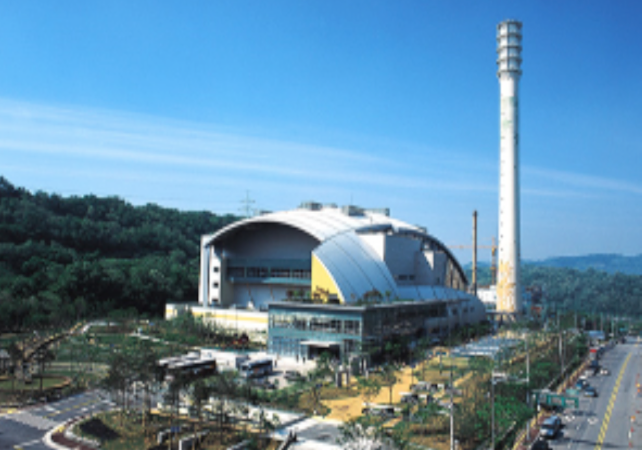
(Source: https://seoulsolution.kr)
Relevance with Other Policies
1) Sangam New Millennium Town Project
Figure 7. Sangam New Millennium Town and Nanjido Ecological Park
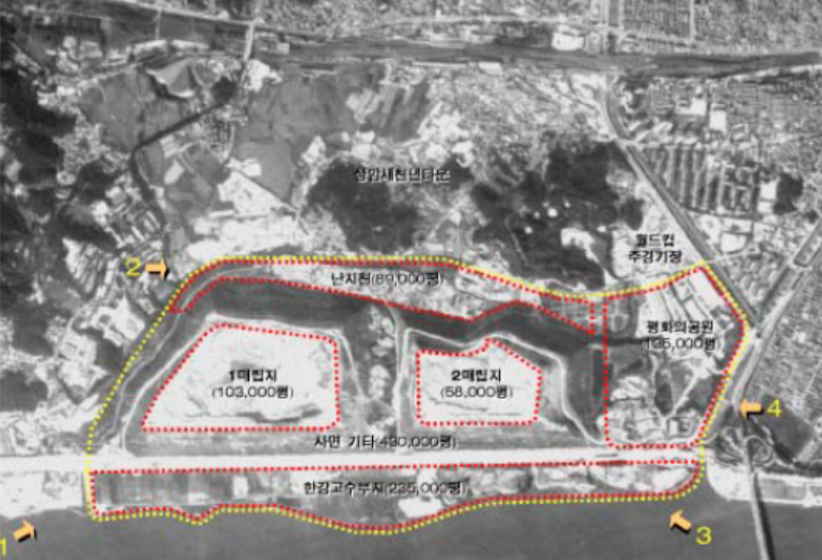
(Source: https://seoulsolution.kr/)
Additionally, the land was divided into various sections (Digital Media City, an eco-friendly housing complex, and World-cup Park) to help shape Sangam as a new city combining downtown functions, distribution, housing, with parks and green fields.
2) New Han River Development
Policy Objectives
Nanjido, however, raised different issues – including air and water pollution, odor, harmful insects, and safety for the surroundings as an insanitary landfill for 15 years. As addressed before, discussions took place to relocate the waste and use the land for new purposes, or stabilize the waste and avoid its short-term use for the future. Finally though, a decision was made to build the Nanjido Ecological Park. By developing the ecological park, the abandoned land was recycled as an eco-friendly space for the new millennium suggesting future-oriented environmental alternatives and representing proud cultural characteristics.
The second political objective was to improve the surroundings of the Sangam World-cup Stadium by developing the Nanjido Ecological Park. Korea was selected as a host for the 2002 World Cup and Sangam was the site for main World-cup stadium in Seoul. But the surroundings were poor. It was vital to address the mountains of waste at the Nanjido landfill site, polluted streams, and housing for the poor. So, the ecological park development project was responsible for the large-scale environment rearrangements for the surroundings.
Thirdly, Seoul tried to transform Sangam into an eco-friendly town in order to to address the rapidly increasing demand for housing in the 1990s. Seoul actively developed housing sites because of the increasing demand for development and housing in the 1990s. Sangam was no= exception as it had detached houses, settlements, and faming land. Thus, it was planned to build housing to transform Sangam into a sub-center while developing a large park in Nanjido to improve the life quality of citizens and build the Sangam New Millennium Town as an eco-friendly city serving as a supporting green field.
Main Policy Contents
The Nanjido Ecological Park development consists of the landfill stabilization and park development and cost 232.2 billion KRW (140.5 billion KRW for the stabilization and 82.7 billion KRW for the park development). The expenditures were covered with the general funds of Seoul.
Figure 8. Organization for Nanjido Ecological Park Development project
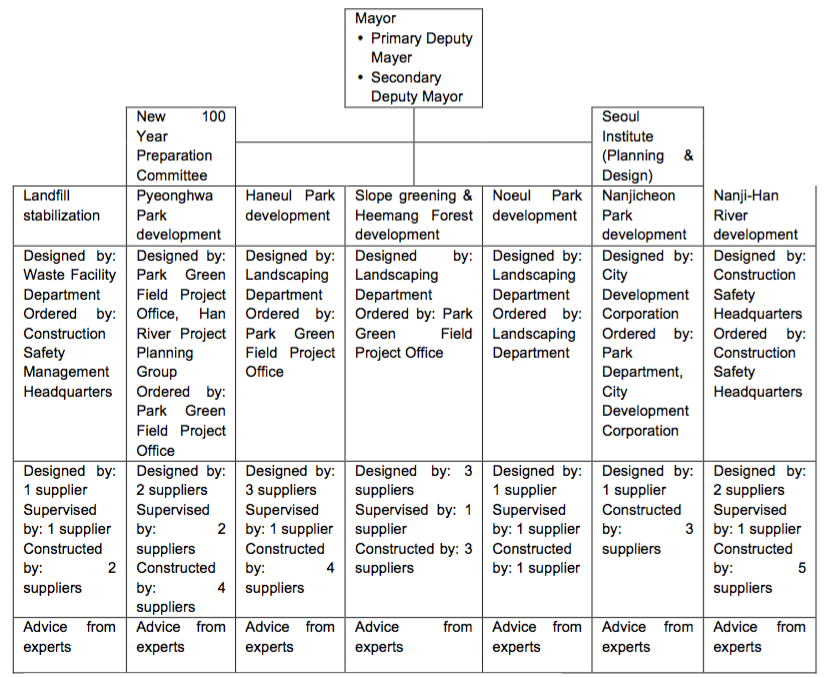
(Source: Seoul Institute, 2014, “2014 Economic Development Experience Modularization Project: Recovery of Nanjido Ecological Park”)
1) Nanjido stabilization
2) Ecological park development
Figure 9. Bird’s-eye view of Nanjido Ecological Park
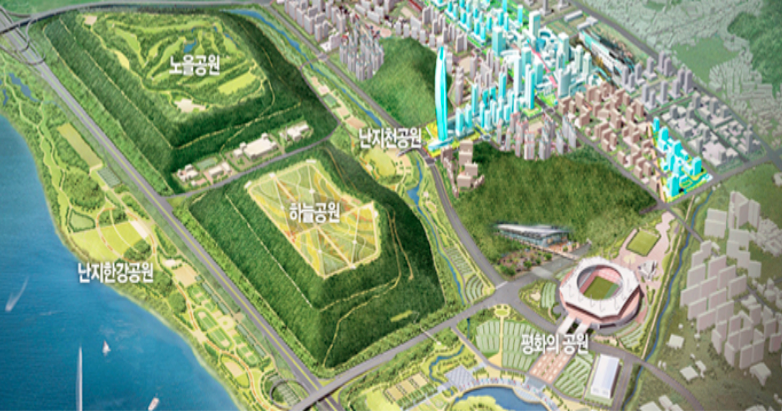
Source: http://worldcuppark.seoul.go.kr
3) Sustainable waste management
Figure 10. Resources collecting and related facilities
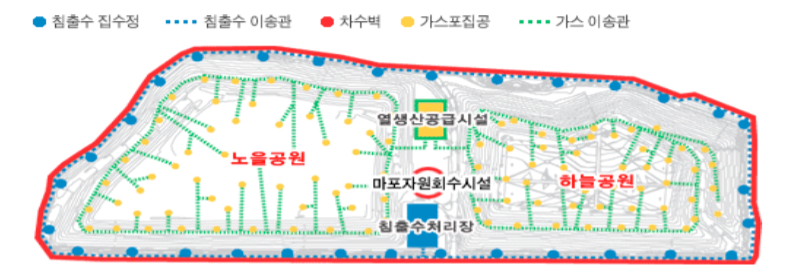
Source: http://worldcuppark.seoul.go.kr
Technical Details
1) Stabilization

The stabilization aims at isolating the waste accumulated for 15 years and thus restoring the surrounding environment. The stabilization consists of barrier wall installation and leachate processing to prevent water pollution, landfill gas collection and processing, stabilization of the slope, and top molding for grass fields.
The leachate facility has intercepting and processing equipment. The intercepting equipment (barrier walls and collecting wells) isolates the leachate and keeps stable levels of leachate in the landfill to prevent collapse of the slope. 31 horizontal-drainage collecting wells were installed to 3m depth of the bottom layer with the Caisson method. This method is especially good with underground water level control and low costs. The barrier wall isolates the leachate and was installed at a depth of 19-48m at 6,235m distance by combining the S.S.P Wall and C.B.S Wall. The leachate is stored in the collecting wells; from there it is sent to the leachate treatment station and the Nanji Sewage Treatment Plan using pumps. Finally, it is discharged into the Han River.
The landfill gas produced with the biodegradation of waste is collected and then processed. The average production of Nanjido landfill gas is 432KN㎥/day, which is mainly composed of methane (51%) and carbon dioxide (46%). To prevent odor diffusion and any risk of explosion of landfill gases, the top of landfill was covered with a blocking layer. The landfill gas processing collects and processes harmful gases in a safe manner and provides habitats for plants. The reflected collection of landfill gas was 300N㎥/min through 55 and 51 vertical collecting wells installed at 120m intervals on both the top and slope, respectively. The gas is collected at the landfill gas processing facility for district heating while the remaining is burnt. The landfill gas collecting and processing facilities are managed by the Korea District Heating Corporation.
Figure 10. Design concept of slop stabilizing facility for Nanjido Landfill Stabilization
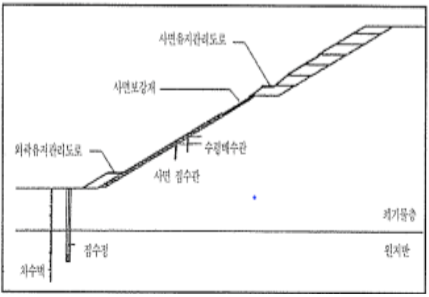
(Source: Yeong Kuk Lim, 2006, Nanjido Landfill Stabilization)
The slope stabilization is to prevent its collapse while minimizing rainwater penetration. Any slope with a inclination under 1:2 was maintained while those over 1:2 were adjusted with a 9m protection installed. The maintenance stage performs continuous slope inspection, waterway repairing, and maintenance to prevent slope loss. Lawn and Leafy lespedeza was planted on any vegetation-vulnerable slope for better stability. Any potentially collapsing slope was covered with tent fabrics to prevent further damage from occurring. Additionally, regular safety inspections were performed biennially by external experts, including professional engineers.
The top arranging and molding work installed water shields (HDPE) to prevent rainwater penetration and covered the top with earth to encourage the growth of plants. The molding consists of a 50cm supporting layer, 1.5mm shield layer (HDPE), a 30cm drainage layer, filtering felt, a 30cm vegetation layer, and a 30cm surface layer in the order to create a 1.4m depth on average. The top is arranged to have an approximately 4% slope to easily avoid rainwater and encourage plant growth. The future subsidence was estimated with the hyperbolic method of the Gibson &Lo Model and Power Creep Law and then reflected on the top arranging and molding. Maximum subsidence was estimated in the center by over 3.6m for 20 years.
Table 1. Details of Nanjido Ecological Park project
| Classification | Project details |
| A. Top arranging and molding | |
| 1) Purpose | ∙Top: Minimized rainwater penetration and thus leachate production, prevention of surface gas leakage, and vegetation ∙Slope: Maintenance of currently stable slopes while recovering vegetation and installing protection on surrounding sections and banking around the outskirts and slope maintenance roads |
| 2) Arranged inclination on top | ∙About 4% of arranged inclination for good rainwater avoidance |
| 3) Cross section of top molding layer | ∙Top molding layer (1.4m): Surface (30cm), vegetation (30cm), drainage (protection, 30cm), blocking (HDPE 1.5mm), and supporting (50cm) layers ∙Dynamic compaction for landfill gas collecting well, pipelines, and roads |
| B. Blocking of leachate | |
| 1) Purpose | ∙To prevent diffused leachate pollution in the adjacent Nanji Stream, Bulkwang Stream, Han River, and others |
| 2)Installation section & method | ∙Barrier walls were fully-installed around the landfill with Coment Bentonite Slurry Wall and Steel Sheet Pile. |
| 3)Installation depth & distance | ∙Depth: Penetration of 1m and 0.5m into weathered rock and soft rock, respectively ∙Distance: 6,235m (S.S.P : 3,320m, C.B.S : 2,915m) |
| C. Intercepting and processing of leachate | |
| 1) Purpose | ∙Optimized intercepting and processing of leachate from the slope and foundations |
| 2) Slope collecting facility | ∙Slope collecting pipe: 6,003m, MAT type pipe: 3,622m ∙Horizontal drain: 667 holes |
| 3) Intercepting facility | ∙Horizontal draining type collecting well: 31 points, Horizontal strainer: 9,300m (186 holes) |
| 4) Transfer facility | ∙Non-pressure flow pipe (MDPE): 5,186m, Forced flow pipe (PEM): 2,035m ∙Intermediate pumping station: 3 points |
| 5) Processing facility | ∙ On-demand pretreatment and then transfer to Nanji Sewage Treatment Station for the separate processing ∙Process: Flow Control+Collection & Precipitation+Penton Oxidation ∙Capacity: 1,860 tons/day |
| Classification | Project details |
| D. Collection and processing of produced gas | |
| 1) Purpose | ∙Collecting and processing of gas (375N㎥/min) produced during degradation of wastes |
| 2) Collecting facility | ∙Extracting well: 106 points |
| 3) Transfer facility | ∙Transfer pipe (HDPE): 13,250m |
| 4) Processing facility | ∙Blower: 5 EA |
| E. Slope stabilization | |
| 1) Purpose | ∙To prevent collapse of slopes and minimize rainwater penetration |
| 2) Horizontal drain facility | ∙Length: 9m , Installation: 667 points |
| F. Sewage sludge processing | |
| 1) Purpose | ∙To eliminate hazards by processing and disposing the landfill sludge (565,882㎥) and thus increase the recycling and land utilization |
| 2) Method | ∙Banking material for landfill bottom arrangement: 202,210㎥ ∙Utilization of sludge-mixed earth and sand as molding material: 16,890㎥ -Supporting layer: 91,570㎥ -Vegetation layer: 77,320㎥ (top+slope) ∙Soil-like: 194,700㎥ |
(Source: Yeong Kuk Lim, 2006, “Nanjido Landfill Stabilization”)
2) Ecological park project
① Pyeonghwa Park
Figure 13. Framework plan for Pyeonghwa Park
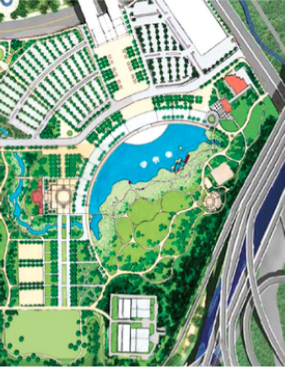
(Source: http://www.lafent.com)
② Haneul Park
The master plan was established by the Master Plan Commission for Millennium Park; the landscaping and working design was performed by Yooshin Corporation Co., Ltd. and Pyeonghwa Engineering Co., Ltd.; the construction was performed by Bando Environment Development Co., Ltd., Imwon Development Co., Ltd., and Dongil Construction Co., Ltd. A total of 25.6 billion KRW was spent on the Haneul Park development. It was built with to a concept of a vast grass field and separated into 4 zones – with the ridge formed for drainage and the high grass field developed in the South-North section and low one in the East-West section. The South-North section had silver grass and the equivalent perennial grass field while the East-West section had mainly wild grass and some naturalized grass fields to demonstrate the stages of succession between them later. The entire area has drainage gradient of 4-8% with the cross management roads. For stabilization, the available vegetation depth was only 60cm on top of the water blocking layer and the ground was unstable so the planting of trees and installation of structures was prevented. Haneul Park has vast grass fields and the Silver Grass Festival is held there every October.
③ Noeul Park
④ Nanjicheon Park
The Nanjicheon Park was developed for residents in the Sangam New Millennium Town - especially the disabled, old and infirm, and youth. Thus, a lawn picnic field was built sloping down toward the pond with special and natural playgrounds using natural materials and topography. The trail and stepping stones were installed around the pond so that family visitors can have the opportunity to study the wetland ecology. Furthermore, the Nanjicheon Park has sports and game facilities for the residents. It caters especially for the disabled and old, with sports facilites arranged in small groups along the road in the forest to alleviate desolateness. Curved trails were installed between the sports facilities and stream to improve accessibility to the stream’s edge and different types of wild plants.
⑤ Nanji-Han River Park
Figure 14. Pyeonghwa Park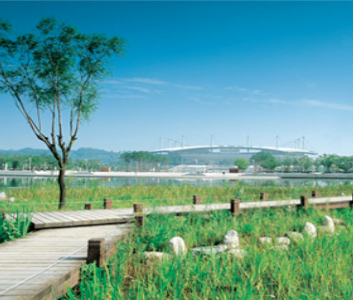
Source: http://worldcuppark.seoul.go.kr |
Figure 15. Haneul Park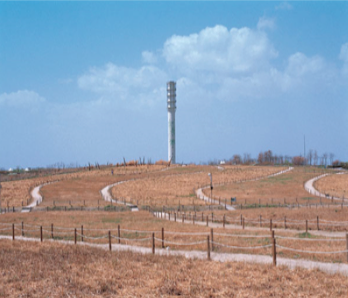
Source: http://www.lafent.com |
||
Figure 16. Noeul Park
Source: http://worldcuppark.seoul.go.kr |
Figure 17. Nanjicheon Park
Source: http://worldcuppark.seoul.go.kr |
||
Figure 18. Nanji-Han River Park
Source: http://hangang.seoul.go.kr/archives/3021 |
|
||
Policy Effects
1) Environmental effects
After the ecological park development project, the ecosystem and surroundings of Nanjido have considerably improved. Over 1 million trees and herbaceous plants have been planted. It was reported that there were 89 types of 24 families of plants in 1994, which is only 1 year after the last landfill had taken place. Within 3 years, grass and trees had covered the slopes of the waste piles and the plant species had extended to 271 types of 60 families compared to 1994. These continuously extended to 502 types of 95 families until 2010. The plant species were naturally extended with different types of naturalized plants. Naturalized plants were brought in and adapted to the poor environment during the landfilling so 50% of naturalized plants in Korea were found there. This formed a very unique and notable ecosystem. Currently, only 22% of naturalized species have survived because of succession. The inhabitation of birds, insects, amphibians, fishes, and mammals has also increased. Before the park was developed, 167 types of animals had been reported to live there; this was increased to 731 types after the Nanjido Ecological Park was developed, which is a sign of healthy ecology. A continuing increasing number of birds inhabit the Han River, Nanji Pond, Nanji Stream, and mountains. It was also found that endangered species are now living there: narrow-mouthed toads and wildcats.
Figure 19. Narrow-mouthed toads found in the Nanjido
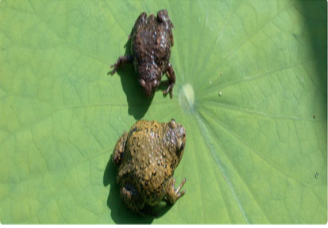
Source: http://worldcuppark.seoul.go.kr
Figure 20. Acacia flows found in the Nanjido
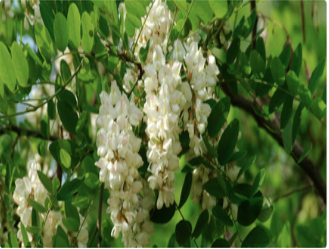
Source: http://worldcuppark.seoul.go.kr
Moreover, the Nanjido Ecological Park development contributed greatly to improved biodiversity and water quality. Seoul investigates the environment around the Mapo Resources Recollection Facility at 3 year intervals. These have shown that all environmental criteria are met for the air quality, noise, water quality, and soil. There are no residents around the Mapo Resources Recollection Facility so the investigation range is extended to a 2km radius, which includes the entire Nanjido Ecological Park.
2) Economic effects
The surroundings of Nanjido were left undeveloped before the World-cup Park was developed because there of odor and environmental pollution and thus the demand for housing was low. However, the surrounding ecosystem and environment were considerably improved with the ecological park development and Digital Media City plans and this resulted in increased land prices. The competition rate of subscription was very high for the Sangam Housing Site Development Zone in 1999 with a land price of 900,000 KRW per 1㎡ in 1996 increased to 1,200.000 KRW to 1,500,000 in 1999. This was aided by the announcement thatthe Sangam area would be transformed into a special housing area (21C New Seoul Town) with leisure, shopping, and cultural facilities, Nanjido Ecological Park and water park, as well as different types of amenities and sports facilities. The housing site development area was 1,450,000 ㎡, which exceeded the side of one of most popular districts, Yongin & Suji District (1,350,000 ㎡).
3) Sociocultural effects
Additionally, Seobu Park & Green Field Office, Green City Division, Seoul is operating monthly firefly eco center description programs, silkworm ecology tours, and different programs using natural objects for the citizens to experience the Nanjido Ecological Park. The environment programs are free for children and families, and more families are applying for the environment experience as eco-friendly education becomes more and more popular.
Table 2. Ecology program of World-cup Park
| Program name | Day | Time | Workforce | Subject | Description |
| Kindergarten Let's play in the forest! |
Tue-Thu | 10:00-12:00 | 20 | 6 to7-year-old groups |
- To know seasonal changes - To walk in the park the things that disappear in winter - To share the dreams of children |
| Korean paper experience | Sat-Sun | 10:30-11:20 14:00-14:50 |
20 | Families | - Explanation of process from paper mulberry to paper - To recognize the importance of Korean paper by making Korean-paper post cards by themselves |
| Wood handcrafts | Sat-Sun | 13:30-14:50 10:30-11:50 |
20 | Families | -To make creative pieces using waste wood - Importance of natural recycling |
| Firefly description program |
Tue-Fri | 10:00-12:00 14:00-16:00 |
20 | Anyone | - Description about fireflies at the eco center - Description of the ecology of firefly, and observation of larva and imago |
Source: http://worldcuppark.seoul.go.kr
The Nanjido Ecological Park draws high attention from other countries. It is an excellent and exemplary landfill recovery and development project. It has been benchmarked by developing countries such as Indonesia and Cambodia, and serves as a stepping stone for Korea to enter environment markets of other countries. Pleasingly, it receives high attention from municipalities of developing countries for the sustainable urban development.
Challenges & Solutions
Another challenge of the Nanjido Ecological Park development was the purpose issue of Noeul Park. Noeul Park was originally planned as the Nanji Golf Course. The Korea Sports Promotion Foundation was eventually selected as an investor in March, 2000 so it invested 14.6 billion KRW to develop a 9-hole golf course in Noeul Park and open it in October, 2005. However, the land owner, Seoul City Government and Korea Sports Promotion Foundation had conflicting ideas concerning the operation method and management rights so they undertook legal proceedings. Furthermore, Seoul amended the ordinance to transform the golf course into a park and the Korea Sports Promotion Foundation opened the golf course for free. Finally, Noeul Park was turned into a real park and Seoul compensated the Korea Sports Promotion Foundation with 18.5 billion KRW, including the Nanji Golf Course development expenses. The Korea Sports Promotion Foundation transferred the ownership of the golf course to Seoul. Seoul then spent an additional 4 billion KRW installing new trails, water supplies, drinking fountains, toilets, shade canopies, and benches while trying to retain as much of the lawn field of 9-hole golf course as possible so as to renovate it as a family park and thus invite more visitors.
References
- Seoul Institute, 2014, “2014 Economic Development Experience Modularization Project: Recovery of Nanjido Ecological Park”
- 2002 FIFA World Cup – Details Plan for Environment Improvement Project –Seoul Policy Archive, 2014, “Framework Plan for Millennium Park”
- Environment Preservation Department, World-cup Park Management Office, Seoul; 2006; “Nanjido recovers the scent.”
- Yeong Kuk Lim, 2006, “Nanjido Landfill Stabilization”
- Deok Hyeon Cho (2005) Comparative analysis of Namsan Park and World-cup Park: Focusing on construction process and use state, Master’s Degree paper of University of Seoul
- Seoul Institute, 2014, “2014 Economic Development Experience Modularization Project: Recovery of Nanjido Ecological Park”
- Seoul Institute, 2014, “2014 Economic Development Experience Modularization Project: Recovery of Nanjido Ecological Park”
- Seoul Institute, 2014, “2014 Economic Development Experience Modularization Project: Recovery of Nanjido Ecological Park”
- Seoul Development Institute, “Framework Plan for Sangam New Millennium New City,” 2000
- Seoul City Government, “Framework Plan for Millennium Park,” 2000
- Seoul Institute, 2014, “2014 Economic Development Experience Modularization Project: Recovery of Nanjido Ecological Park”
- Seoul Institute, 2014, “2014 Economic Development Experience Modularization Project: Recovery of Nanjido Ecological Park”
- Ministry of Environment (2010) Guideline for Terminated Landfill
- Seoul Institute, 2014, “2014 Economic Development Experience Modularization Project: Recovery of Nanjido Ecological Park”
- Environment Preservation Department, World-cup Park Management Office, Seoul; “Nanjido recovers the scent”; 2006
- Yeong Kuk Lim, 2006, “Nanjido Landfill Stabilization”
- Mapo Resources Recollection Facility, Seoul meets the environment criteria for surrounding, air, noise, water, and soil
- Home page of Seoul Policy Archive, Nanjido Ecological Park Development
- Sang Wook Cho, Maeil Economy, March 19, 1999
- Backwaters of Waste Mountains, Nanjido People Feb.1, 1993
- Nanji Golf Course will be transformed into a family park.
.PNG)
.PNG)
.PNG)
.PNG)
.PNG)
.PNG)
.PNG)
